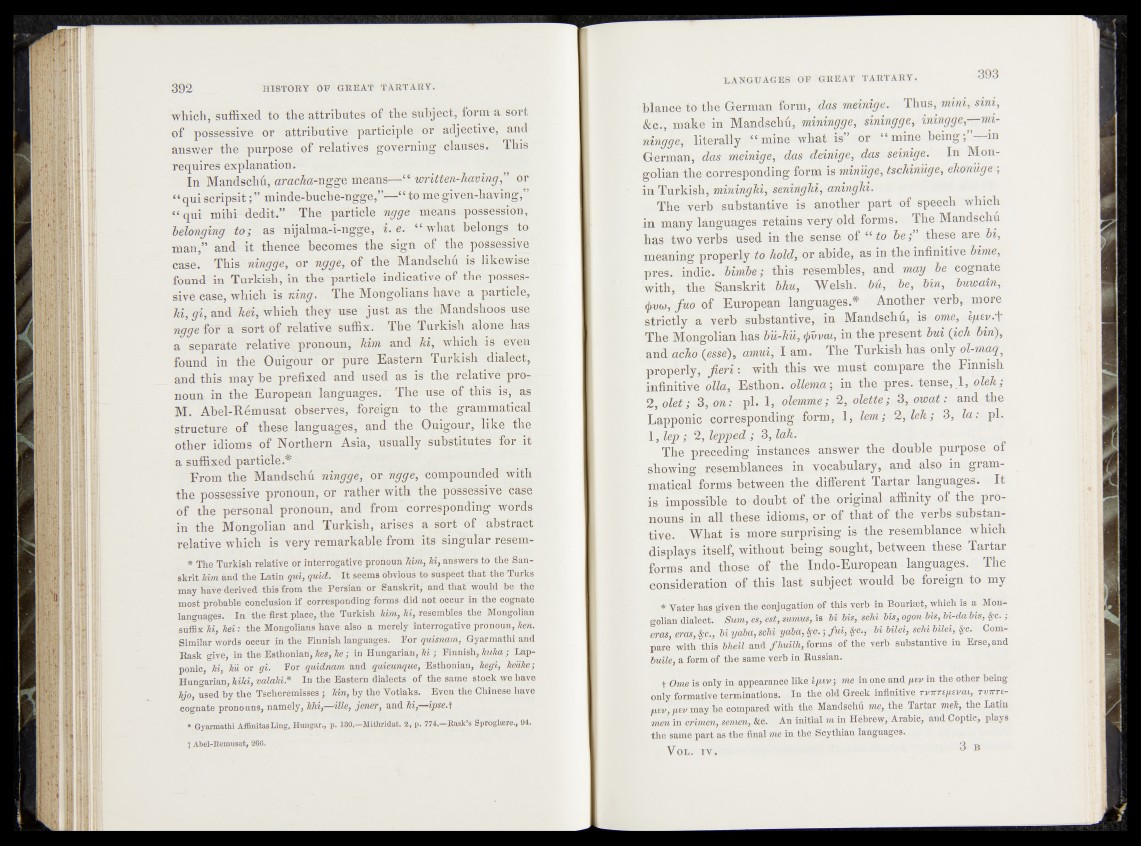
which, suffixed to the attributes of the subject, form a sort
of possessive or attributive' participle or adjective, and
answer the purpose of relatives governing clauses. This
requires explanation.
In Mandschû, aracha-ngga means—*•“ written-having, or
“ qui scripsit ; 1 minde-buche-ngge,”—‘‘ to me given-having,”
“ qui mihi-dedit.” The. particle ngge means-possession,
belonging to; as nijalma-i-ngge, i. e. “ what belongs to
man,” and it thence becomes the sign of the possessive'1
case. This ningge, or ngge, of the Mandschû is likewise .
found in Turkish, in the particle indicative of the possessive
case, which is ning. The Mongolians have a particle,
hi, gi, and kei, which they use just as the -Mandshoos use
ngge for" a sort of relative suffix. The Turkish alone has
a separate relative pronoun, Mm and hi, which is even
found in the Ouigour or pure Eastern Turkish dialect
and this may be prefixed and used as is th^^eiatïké pronoun
in the European languages.' The die of this 'is, as
M. Abel-Rémusat observes, foreign to the grammatical
structure of these languages, ând the Ouigour, liS4’ the
other idioms of Northern Asia, usually substitutes for it
a suffixed particle.*
From the Mandschû ningge3 or ngge, compounded with
the possessive pronoun, or rather with the po*#s)e‘ssi^vej|as,e
of the personal pronoun, and from'corresponding words
in the Mongolian and Turkish, arises â sort Of Abstract
relative which is very remarkable from its singular fesem-
* The Turkish relative or interrogative pronoun Mm, M, answers to theSau-
skrit Mm and the Latin qui, quid. It seems obvious to suspect that the Turks
may have derived this from the Persian or Sanskrit, and that'would be the
most probable conclusion if corresponding forms did not occur in the cognate
languages. In the first place, the Turkish Mm, hi, resembles the Mongolian
suffix M, Mi: the Mongolians have also a merely interrogative pronoun, hen.
Similar words occur in the Finnish languages. For qwisnam, Gyarmathi and
Rask give, in the Esthonian, hes, he ; in Hungarian, hi ; Finnish, huha ; Lap-
p0nic, M, M or gi. For quidnam and quicunque, Esthonian, hegi, he'dhe;
Hungarian, kiki, valahi.* In the Eastern dialects of the same stock we have
Mo, used by the Tscheremisses ; Mn, by the Votiaks. Even the Chinese have
cognate pronouns, namely, hhi,—tile, jerier, and hi,—ipse.t
* Gyarmathi AffinitasLing. Hungar., p. 130,-Mithridat. 2, p. 774.—Rask’B Sproglære., 94.
{ Abel-Remusat, 266.
blance to the German form, das meinige. Thus, mini, sini,
&c., make in Mandschti, miningge^siningge, iningge,—-mi-
ningge, literally “ mine what vis” or “ mine being;”—in
German, das. meinigkffi-das deinige, das seinige. In Mongolian
the corresponding-form is minuge, tschiniige, ehonuge,
in Tu rkish, aninghir^M *' -**>'■>**
The v'erb substantive is another part of speech which
in many languages retains very old forms. The Mandscldj
has two verbs used in the sense of “ to be; these are bi,
meaning properly to hold^ or abide* as in the infinitive bime,
pres, indie, bimbe ; this resembles*, nod mag be cognate
with, the Sanskrit bhu, Welsh, bu, be, bin, buwain,
fuo of European languages.* Another -verb, more
strictly a verb rsubstantive, in Mandschu, isKlpme9 egev.f
The Mongolian has b‘u-hu,j^vvm, in the present buv(ich bin},
and acho (esse), emui, I am. The Turkish has only ql-maq?
properly, fieri: with this we must compare the Finnish
infinitive olla, Esthon. ollem,a; in the pres, tense, \ , oleh;
2, olet; 3, on: pi. 1, olemme ; ^^o^ttg^^ owat: and the
Lapponic corresponding forin, 1, lem; ^,ylek; 3, la: pi.
1, lep; 2, lepped ; 3, lah.
The preceding instances answer tkef double purpose of
' ^hawing resemblances,hin. vocabulary, and rIsp in grammatical
forms between the different Tartar languages. It
is impossible to doubt of the original affinity of the? pronouns
in all these idioms, qj^e^that of the verbs substantive.
What is more surprising is the resemblance which
displays itself, without being sought,., between th^e Tartar
forms and those of the Indo-European languages.!« The
consideration of this last subject would be foreign to' my
* Vater has given the conjugation o'f this verb-i in Bouriset, which is a Mongolian
dialect. Sum, espest, sumus, is bi bis; sefoi bis,<ogdn Ms, bi-daibis, j
eras, eras, &-c., bi ydba, sefcf ydba, $c. j ^ m e ^ s ^ iM l e i^ $c. Compare
with this bheil m d fhuilh^ forms- of the verb substantive in Erse, and
buile, a form of the same Y,erti-in Russian.
f Ome is only in appearance like, tpey.; me in one and per in the other being
only formative terminations.,, In the cid Greek infinitive Twrepevai, tvttte-
p e v .p iv may be compared with the Man'(|sch& mer the Tartar raefc, the Latin
men in ^crimen, semen, &c. An initial m in Hebrew, Arabic, audCoptic, plays
the same part as the final me in, the. Scythian languages.
V oL . i v . . . •’ - v ' 1 3 B